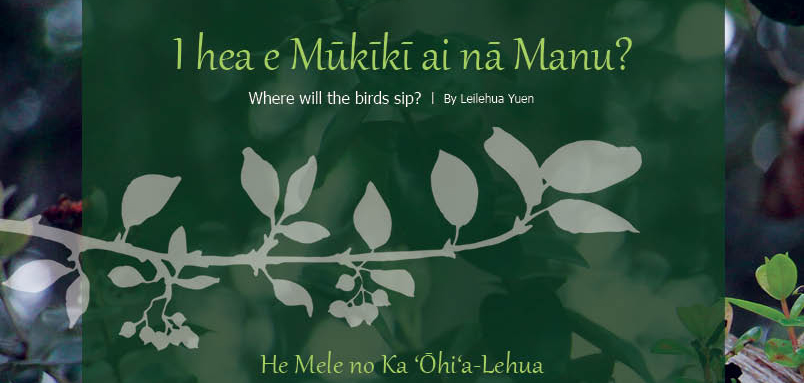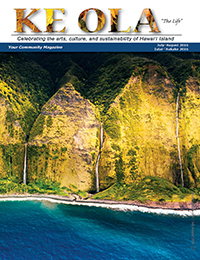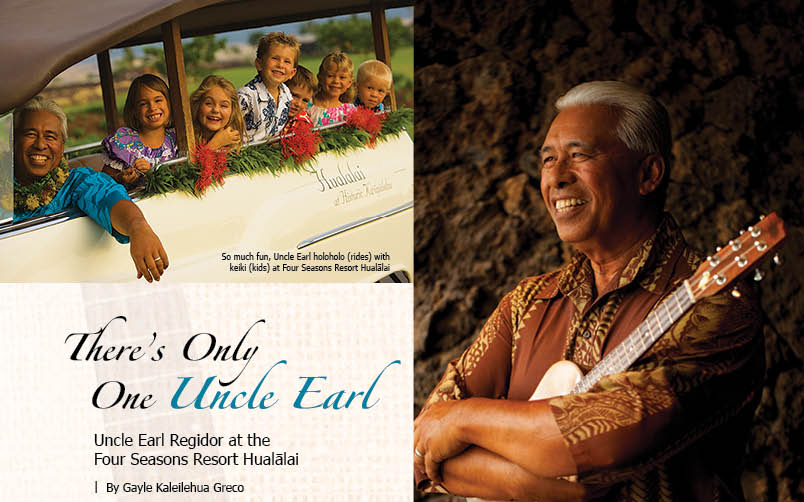
I hea e Mūkīkī ai nā Manu? Where Will the Birds Sip?
He Mele no Ka ‘Ōhi‘a-Lehua
| Aloha ka ‘āina maika‘i Aloha nā makani, ka hā o Ke AkuaAloha ka ‘āina kapu Aloha ka hū, ka hā o Ka Wahine Aloha ke kuahiwi Aloha ke kula ēAloha ka wekiu Aloha ka noe, kolokolo i ka uluwehi Aloha nā mauna Aloha nā pali kai ē‘Auhea wale ana ‘oe e ‘Ōhi‘a o ‘Ōhi‘a‘Auhea wale ana ‘oe e Lehua Lā‘au ‘ohu‘ohu, Pua mohala Nā me‘e o ka mo‘olelo, Ke oli, ke mele Nā hoa aloha I hea, i hea e mūkīkī ai nā manu? Ho‘ina, ho‘ina mai Kūka‘ōhi‘alaka |
Loving farewell to the good land Loving farewell to the winds, the breath of GodLoving farewell to the sacred land Loving farewell to the steam, the breath of the Goddess Loving farewell to the forests Loving farewell to the plainsLoving farewell to the summit Loving farewell to the mist that creeps through the groves Loving farewell to the mountains Loving farewell to the sea cliffsWhere have you gone, Where have you gone, o Lehua Budding tree, Blooming flower Warm companions in story, chant, and song Cherished friends Where, o where shall the birds sip? Return, return Kūka‘ōhi‘alaka |
By Leilehua Yuen
The ‘ōhi‘a-lehua, (Metrosideros polymorpha and M. macropus) is a keystone member of the Hawaiian forest community. Botanists currently divide it into five species:
- Metrosideros polymorpha—The most common species looks as though it could be divided into at least five different species, itself. “Polymorpha” means “many forms,” and this species can range from tall and stately to shrubby and gnarled. The leaves range from thin and smooth to fleshy and fuzzy, with the mu‘o (leaf buds) and liko (budding or newly unfolded leaves) ranging in color from pink to silver. It has adapted to virtually every ecolological zone Hawai‘i has to offer and grows from sea level to about 7,000 foot elevation. The pompon blossoms range from delicate creamy yellow with long tender stamens to deep carmine with short spikey stamens. Salmon, orange, pale green, and even white, though rare, can be found.
- M. tremuloides—Also known as lehua ‘āhihi (the Hawaiian name translates as “entangled,” the Latin as “trembling”), has leaves and branches that are longer and more slender than those of M. polymorpha.
- M. rugosa—The lehua papa (translated as lehua growing close together) earned its Latin name with its rose-like deeply furrowed leaves which grow in rosettes.
- M. macropus—With its long pointed leaves and drooping branches, when not in flower, it looks a bit like a ficus. When its butter-yellow pompons bloom, it is obviously an ‘ōhi‘a-lehua. In this species, yellow is more common than red.
- M. waialeale—Endemic to Kaua‘i, the smooth long slender leaves and tiny mu‘o are distinctive of this lehua.
Each of the lehua is uniquely adapted to its environment, and creates its own microenvironment on which other species of Hawai‘i depend.
The saying He kumu lehua muimui i ka manu, “A lehua tree covered with birds,” is a poetic reference to someone so attractive as to have many suitors, and it also shows the importance of the ‘ōhi‘a-lehua in the forest.
Though it is the first woody plant to colonize fresh lava, it does not stand alone. Its flowers are a critical food source for many native birds, for bees (lehua honey is an important part of our economy), and for butterflies. Its bark catches our tropical rains and provides a spongy medium in which whole communities of epiphites grow. These arboreal communities in turn are home to the small fauna of our islands. Its structure both above and below ground captures the mist of our forests and lets it slowly seep into the ground, replenishing our water supply. Without the ‘ōhi‘a-lehua, the Hawai‘i we know would not exist.
‘Ōhi‘a-lehua is also a critical part of the cultural landscape of the islands. It is a kinolau, a manifestation of Kū-ka‘ōhi‘a-laka. It is an aspect of Kū, one of the four major male deities in traditional Hawaiian pantheon. Kū-ka‘ōhi‘a-laka figures in the practice of certain traditional hula people, carvers, and lei makers. The ‘Ōhi‘a-lehua also is a manifestation of Hina-ulu-‘ōhi‘a, a female deity of canoe carvers.

Traditional Hawaiian people recognized the importance of the ‘ōhi‘a-lehua, and extolled it in numerous chants and songs. It is found in the hula chants of Hi‘iaka and in songs of modern times, and many sayings reference the tree and its flower.
The blossom gives its name to a famous rain of Hilo, Ka Ua Kani Lehua—the rain that moistens the lehua blossoms. This and other sayings, such as I mohala no ka lehua i ke ke‘eke‘ehi ‘ia e ka ua—Lehua blossoms unfold because the rains tread upon them, show an understanding of the relationship between weather systems and the arboreal environment.
Once upon a time, people would say, ‘Opihi kauwawa lehua o Hōpoe—The ‘opihi is covered by the lehua blossoms of Hōpoe, a reference to the days when the ‘ōhi‘a-lehua forests were so extensive they covered the slopes of Puna down to the sea. When they bloomed, the fringes of lehua blossoms fell into the sea and washed up over the rocks, hiding the ‘opihi. Today, how often do we see this once-famous sight?
The wood of the ‘ōhi‘a-lehua was used for many things. It was preferred for carving ki‘i (images), including temple figures and smaller figures. It also was used for temple structures and homes, providing the posts, rafters, purlins, and girts. Strong palisades for heiau were built from it. Occasionally, it might be made into a bowl, though not often, as it is a difficult wood to work. It is so hard that it is an excellent firewood, cooking hot and long.
The more easily worked and less brittle koa is preferred for the hull of a canoe, and the hard ‘ōhi‘a is useful for masts and the rails where the softer koa would wear away from the friction of the lines chafing across it, as well as for the ‘iako (outrigger booms).
The pua (flower) and liko (leaf bud) have been used in lei for so long that these unique garlands appear in ancient legends. In addition to ornamentation, the liko are used in making medicine.
Now, the ‘ōhi‘a-lehua is under attack by various situations, including a vascular wilt fungus, Ceratocystis fimbriata. As of January 2016, 34,000 acres were affected. What is being done to kōkua (help) this iconic tree of our islands? Various groups and individuals are playing different roles.
Another Hawaiian ‘ōlelo no‘eau (wise proverb) says, Ho‘i ka ‘o‘opu ‘ai lehua i ka mapunapuna. The lehua-eating ‘o‘opu has gone back to the spring. It symbolizes returning to one’s source. To do so, we must protect it.
Several community leaders have made statements and published open letters.
Kekuhi Keali‘ikanaka‘oleohaililani wrote how her grandparents taught her that all things are ‘ohana. Refering to her grandmother, “At the forest she would pick liko from the ‘Ōhi‘a, hold it in her fngers, and say, ‘Kekuhi, this is your ‘ohana,’ and we would give a chant of thanks.”
“I continue to dedicate my life to dancing, chanting, singing, and teaching how to Aloha ALL of these ‘ohana…like many of you do in big and little ways through HULA. I am writing because our hula ‘ohana, the tree that is most used in our art form, the tree that is most responsible for making sure that we have water, the tree that is most used in the carving of ki‘i, the tree that we can find on almost every landscape on our island, the tree that many of our bird people depend on, the tree that Hōpoe and Hi‘iaka made lehua lei from, the beloved ‘ŌHI‘A… the tree that my Gramma introduced to me as ‘ohana ~ is being made sick by a fungus, Ceratocystis fimbriata (aka Rapid ‘Ōhi‘a Death or ROD), that lives both in the soil and in the tree. OUR ‘Ōhi‘a needs our attention, our awareness, and our aloha.” (Kekuhi’s letter can be found here.)
JB Friday, of the University of Hawai‘i College of Tropical Agriculture and Human Resources, says CTAHR, the USDA Forest Service, and the USDA Agriculture Research Service all are studying the fungus and the disease.
UH, the DLNR Division of Forestry and Wildlife, the Department of Agriculture, and the Big Island Invasive Species Committee are disseminating information on what people can do. They suggest on their website:
“To reduce the spread of Ceratocystis, landowners should not transport ‘ōhi‘a wood to other areas of Hawai‘i Island, and should comply with the Department of Agriculture quarantine and not ship anything made of ‘ōhi‘a inter-island without a permit.
Tools used for cutting infected ‘ōhi‘a trees should be cleaned with a 70% rubbing alcohol solution.Chain saw blades should be brushed clean, sprayed with cleaning solution, and run briefly to lubricate the chain. Shoes, tools, and clothing used in infected forests should also be cleaned, especially before being used in healthy forests.
Vehicles used off-road in infected forest areas should be thoroughly cleaned underneath so as not to carry contaminated soil to healthy forests.”
CTAHR requests that landowners who suspect they have an infected ohia tree outside of the Puna or South Hilo districts contact them.
Looking to the future, The University of Hawai‘i Lyon Arboretum Seed Conservation Lab will collect and preserve ‘ōhi‘a seeds from all islands for future forest restoration, after the threat of Rapid ‘Ōhi‘a Death has passed.
The project includes sending staff on collection trips to Moku Hawai‘i to target high risk areas and day trips to target ‘ōhi‘a species endemic only to the island of O‘ahu. It will also facilitate collaboration with professional field botanists from partner agencies who will send ‘ōhi‘a seeds from other islands, and work with UH and US Department of Agriculture scientists to optimize the efforts on Moku Hawai‘i. It will provide for long term storage of ‘ōhi‘a seeds in the Lyon Arboretum seed bank. Information on how to participate can be found at the #OhiaLove web page.
“I walea ka manu i ka ‘ula o ka lehua, e ‘āko‘ako‘a ai, mūkīkī ana i ka wai pua.” The bird is attracted by the redness of the lehua and lands to sip the nectar. One is attracted by beauty, yet stays for nourishment. Without the ‘ōhi‘a-lehua, where will they find it? ❖
Learn more: Rapid Ohia Death, Ohia Wilt
Contact Dr. JB Friday, CTAHR | University of Hawai‘i: 808.969.8254
Contact Lyon Arboretum
Photographs courtesy Dr. JB Friday
Contact writer Leilehua Yuen
Bibliography
Emmerson, Sacred texts
Hawaiian Forest
Nupepa Hawaii
Handy, ES Ctraighill and Handy, Elizabeth Green: Native Planters in Old Hawai‘i
Malo, David: Hawaiian Antiquities
Rock, Joseph FC: The Indigenous Trees of the Hawaiian Island



